Trade Protectionism: Impacts and Economic Implications (7303AFE)
VerifiedAdded on 2022/10/08
|6
|1355
|17
Essay
AI Summary
This essay provides an in-depth analysis of trade protectionism, examining its various aspects and implications. It begins by outlining the context of trade protectionism, including the imposition of tariffs by the United States on steel, aluminum, and goods imported from China. The essay explores the impacts of rising tariffs, highlighting that there are no real winners in trade wars, as countries face reductions in exports and GDP. The essay also discusses the retaliatory measures taken by China, the justifications for trade protectionism, and the major effects of trade wars, such as the growth of US debt and the fall of foreign capital inflows. The essay further examines the role of fiscal and monetary policies, aggregate demand and supply, and elasticity in the context of trade protectionism. The analysis covers the effects of protectionist measures on global trade, market failures, and the strategic importance of certain industries. The essay references various sources to support its arguments and offers a comprehensive understanding of the subject.
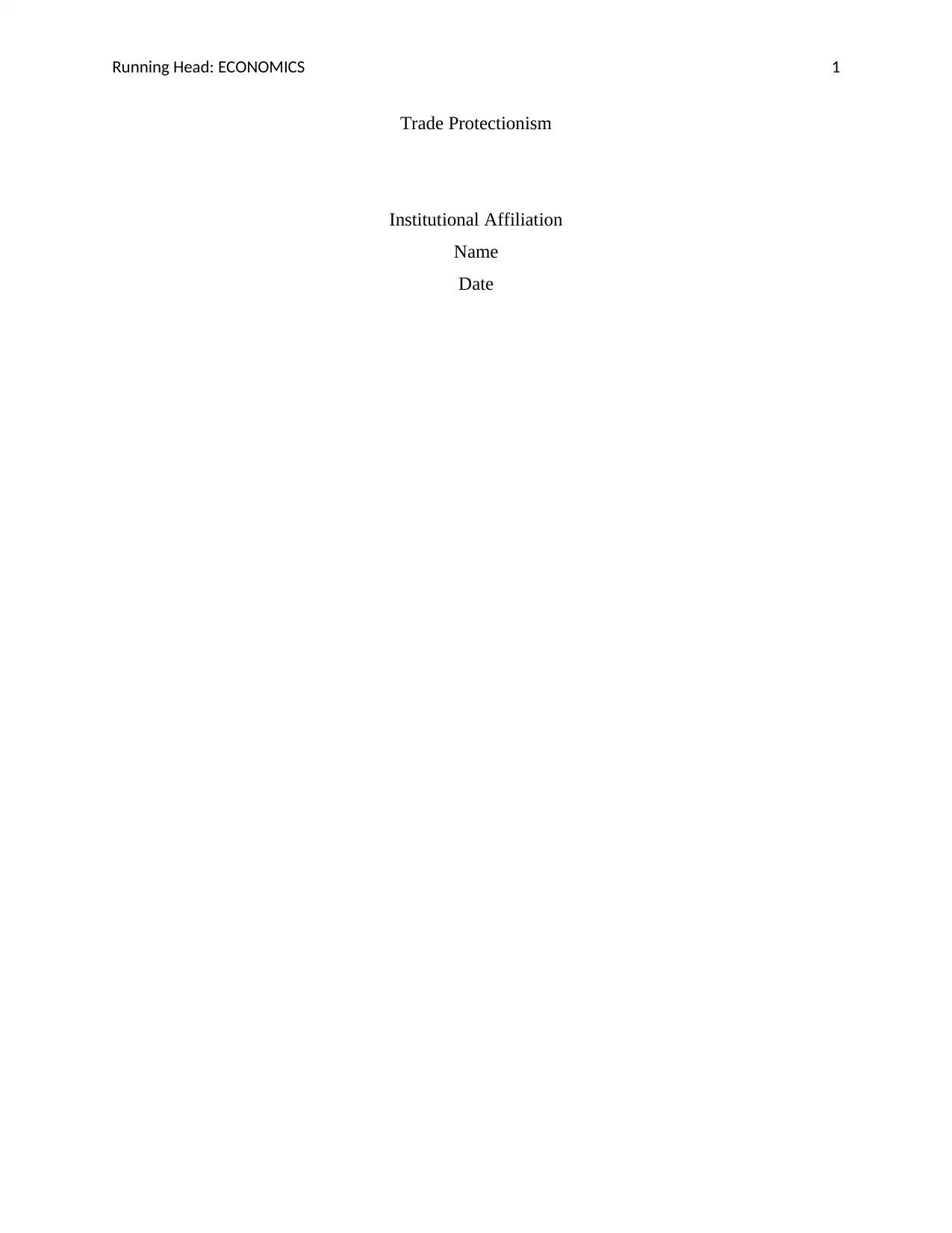
Running Head: ECONOMICS 1
Trade Protectionism
Institutional Affiliation
Name
Date
Trade Protectionism
Institutional Affiliation
Name
Date
Paraphrase This Document
Need a fresh take? Get an instant paraphrase of this document with our AI Paraphraser
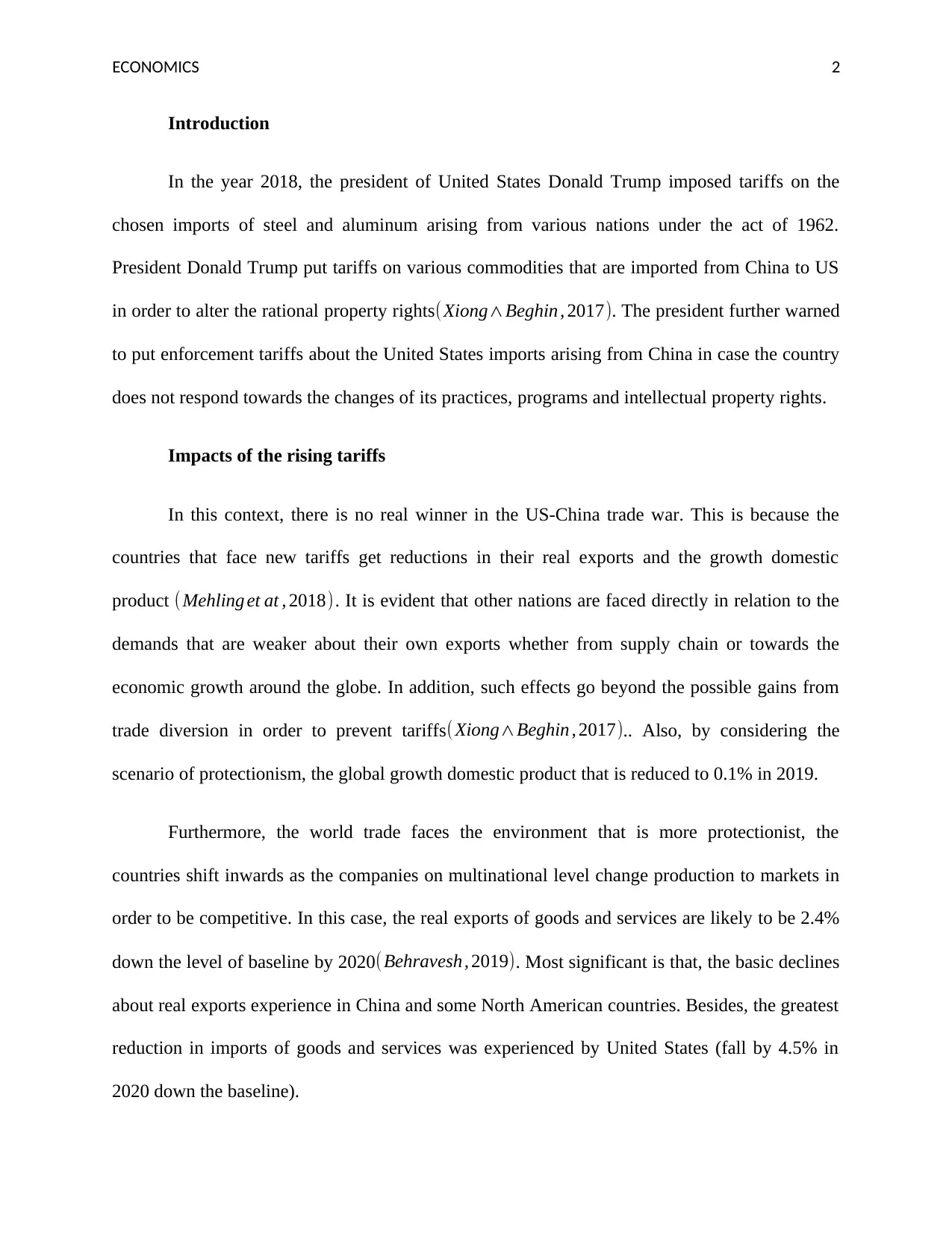
ECONOMICS 2
Introduction
In the year 2018, the president of United States Donald Trump imposed tariffs on the
chosen imports of steel and aluminum arising from various nations under the act of 1962.
President Donald Trump put tariffs on various commodities that are imported from China to US
in order to alter the rational property rights(Xiong∧Beghin , 2017). The president further warned
to put enforcement tariffs about the United States imports arising from China in case the country
does not respond towards the changes of its practices, programs and intellectual property rights.
Impacts of the rising tariffs
In this context, there is no real winner in the US-China trade war. This is because the
countries that face new tariffs get reductions in their real exports and the growth domestic
product (Mehling et at , 2018) . It is evident that other nations are faced directly in relation to the
demands that are weaker about their own exports whether from supply chain or towards the
economic growth around the globe. In addition, such effects go beyond the possible gains from
trade diversion in order to prevent tariffs( Xiong∧Beghin , 2017).. Also, by considering the
scenario of protectionism, the global growth domestic product that is reduced to 0.1% in 2019.
Furthermore, the world trade faces the environment that is more protectionist, the
countries shift inwards as the companies on multinational level change production to markets in
order to be competitive. In this case, the real exports of goods and services are likely to be 2.4%
down the level of baseline by 2020( Behravesh, 2019). Most significant is that, the basic declines
about real exports experience in China and some North American countries. Besides, the greatest
reduction in imports of goods and services was experienced by United States (fall by 4.5% in
2020 down the baseline).
Introduction
In the year 2018, the president of United States Donald Trump imposed tariffs on the
chosen imports of steel and aluminum arising from various nations under the act of 1962.
President Donald Trump put tariffs on various commodities that are imported from China to US
in order to alter the rational property rights(Xiong∧Beghin , 2017). The president further warned
to put enforcement tariffs about the United States imports arising from China in case the country
does not respond towards the changes of its practices, programs and intellectual property rights.
Impacts of the rising tariffs
In this context, there is no real winner in the US-China trade war. This is because the
countries that face new tariffs get reductions in their real exports and the growth domestic
product (Mehling et at , 2018) . It is evident that other nations are faced directly in relation to the
demands that are weaker about their own exports whether from supply chain or towards the
economic growth around the globe. In addition, such effects go beyond the possible gains from
trade diversion in order to prevent tariffs( Xiong∧Beghin , 2017).. Also, by considering the
scenario of protectionism, the global growth domestic product that is reduced to 0.1% in 2019.
Furthermore, the world trade faces the environment that is more protectionist, the
countries shift inwards as the companies on multinational level change production to markets in
order to be competitive. In this case, the real exports of goods and services are likely to be 2.4%
down the level of baseline by 2020( Behravesh, 2019). Most significant is that, the basic declines
about real exports experience in China and some North American countries. Besides, the greatest
reduction in imports of goods and services was experienced by United States (fall by 4.5% in
2020 down the baseline).
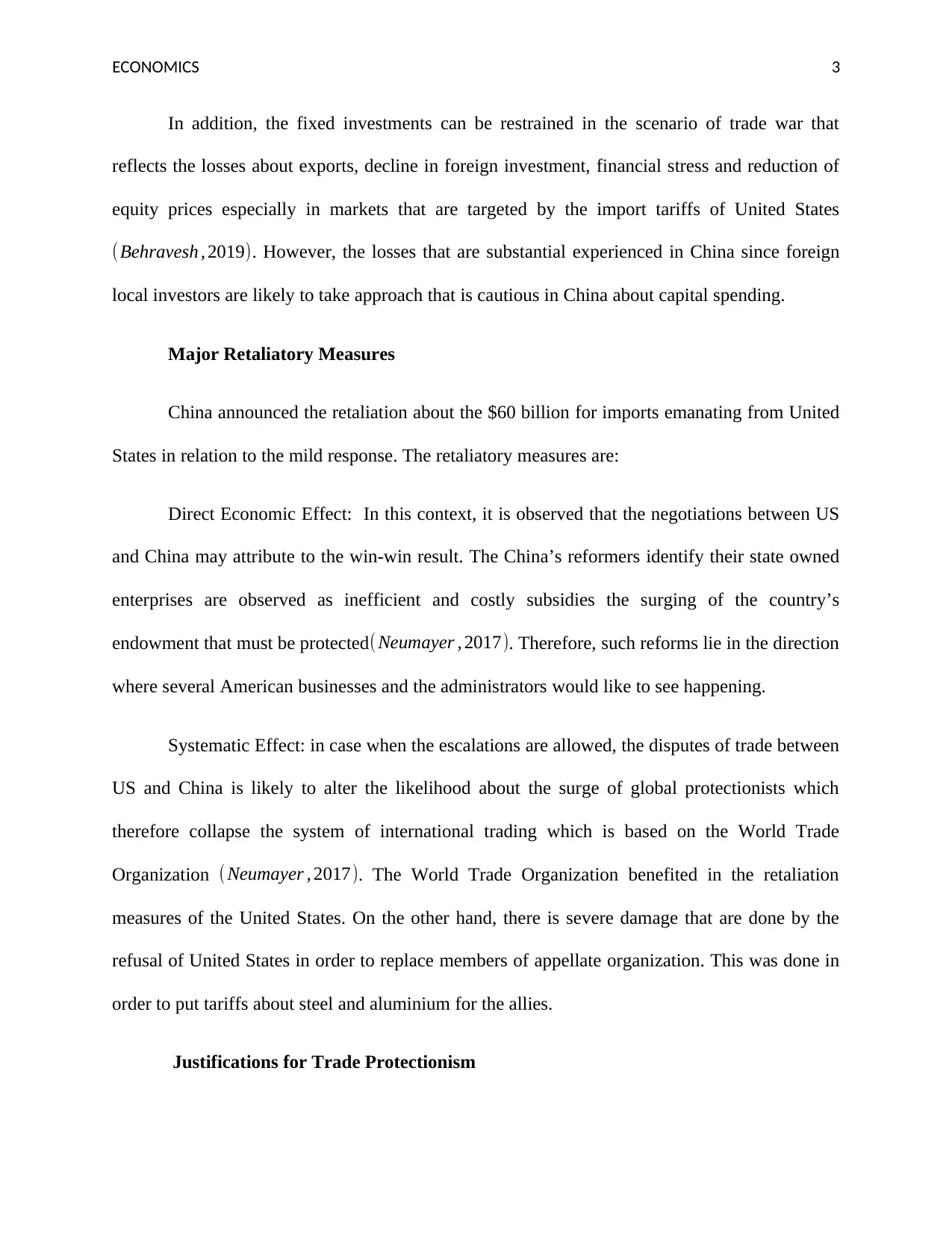
ECONOMICS 3
In addition, the fixed investments can be restrained in the scenario of trade war that
reflects the losses about exports, decline in foreign investment, financial stress and reduction of
equity prices especially in markets that are targeted by the import tariffs of United States
(Behravesh , 2019). However, the losses that are substantial experienced in China since foreign
local investors are likely to take approach that is cautious in China about capital spending.
Major Retaliatory Measures
China announced the retaliation about the $60 billion for imports emanating from United
States in relation to the mild response. The retaliatory measures are:
Direct Economic Effect: In this context, it is observed that the negotiations between US
and China may attribute to the win-win result. The China’s reformers identify their state owned
enterprises are observed as inefficient and costly subsidies the surging of the country’s
endowment that must be protected( Neumayer , 2017). Therefore, such reforms lie in the direction
where several American businesses and the administrators would like to see happening.
Systematic Effect: in case when the escalations are allowed, the disputes of trade between
US and China is likely to alter the likelihood about the surge of global protectionists which
therefore collapse the system of international trading which is based on the World Trade
Organization (Neumayer , 2017). The World Trade Organization benefited in the retaliation
measures of the United States. On the other hand, there is severe damage that are done by the
refusal of United States in order to replace members of appellate organization. This was done in
order to put tariffs about steel and aluminium for the allies.
Justifications for Trade Protectionism
In addition, the fixed investments can be restrained in the scenario of trade war that
reflects the losses about exports, decline in foreign investment, financial stress and reduction of
equity prices especially in markets that are targeted by the import tariffs of United States
(Behravesh , 2019). However, the losses that are substantial experienced in China since foreign
local investors are likely to take approach that is cautious in China about capital spending.
Major Retaliatory Measures
China announced the retaliation about the $60 billion for imports emanating from United
States in relation to the mild response. The retaliatory measures are:
Direct Economic Effect: In this context, it is observed that the negotiations between US
and China may attribute to the win-win result. The China’s reformers identify their state owned
enterprises are observed as inefficient and costly subsidies the surging of the country’s
endowment that must be protected( Neumayer , 2017). Therefore, such reforms lie in the direction
where several American businesses and the administrators would like to see happening.
Systematic Effect: in case when the escalations are allowed, the disputes of trade between
US and China is likely to alter the likelihood about the surge of global protectionists which
therefore collapse the system of international trading which is based on the World Trade
Organization (Neumayer , 2017). The World Trade Organization benefited in the retaliation
measures of the United States. On the other hand, there is severe damage that are done by the
refusal of United States in order to replace members of appellate organization. This was done in
order to put tariffs about steel and aluminium for the allies.
Justifications for Trade Protectionism
⊘ This is a preview!⊘
Do you want full access?
Subscribe today to unlock all pages.

Trusted by 1+ million students worldwide
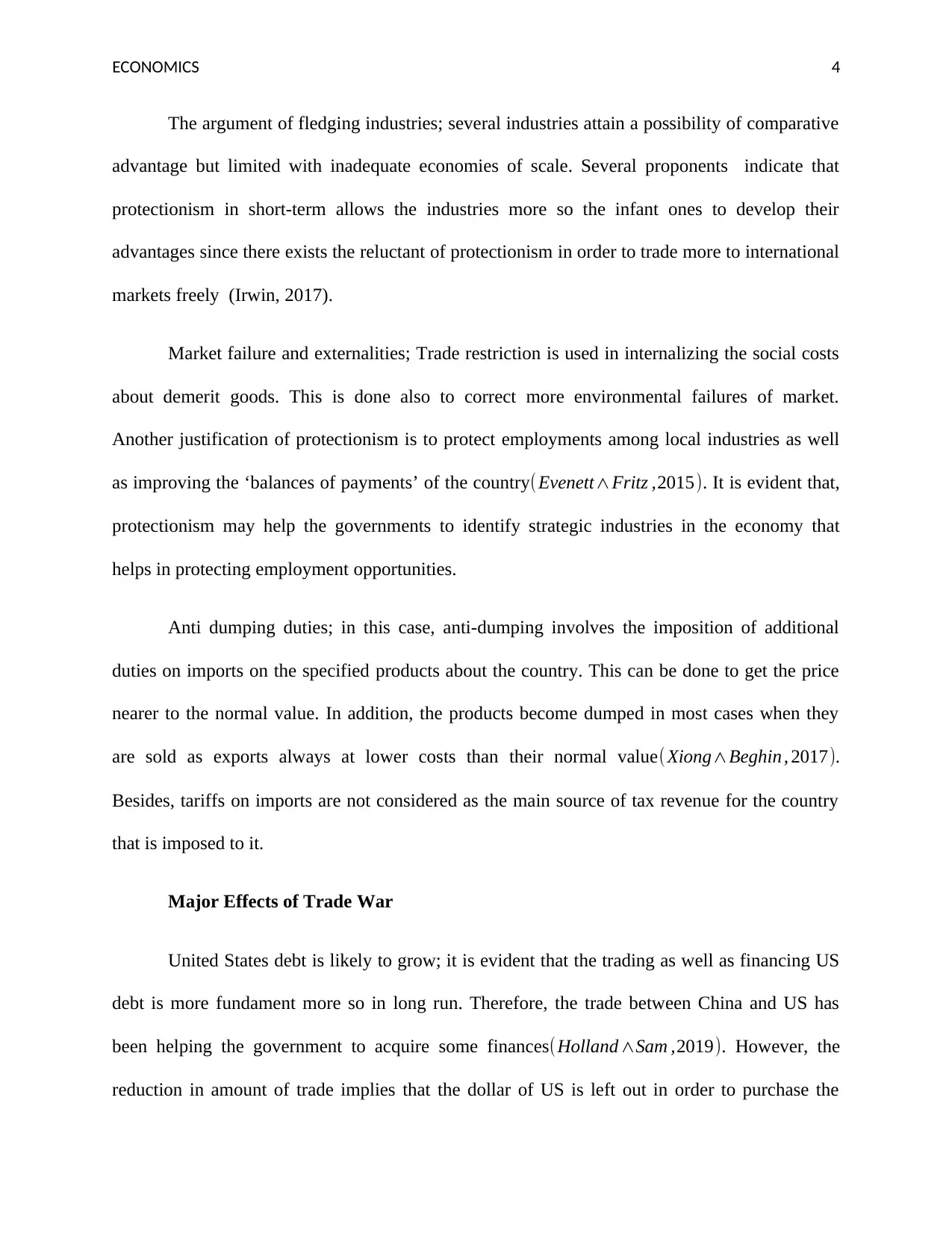
ECONOMICS 4
The argument of fledging industries; several industries attain a possibility of comparative
advantage but limited with inadequate economies of scale. Several proponents indicate that
protectionism in short-term allows the industries more so the infant ones to develop their
advantages since there exists the reluctant of protectionism in order to trade more to international
markets freely (Irwin, 2017).
Market failure and externalities; Trade restriction is used in internalizing the social costs
about demerit goods. This is done also to correct more environmental failures of market.
Another justification of protectionism is to protect employments among local industries as well
as improving the ‘balances of payments’ of the country(Evenett∧Fritz ,2015). It is evident that,
protectionism may help the governments to identify strategic industries in the economy that
helps in protecting employment opportunities.
Anti dumping duties; in this case, anti-dumping involves the imposition of additional
duties on imports on the specified products about the country. This can be done to get the price
nearer to the normal value. In addition, the products become dumped in most cases when they
are sold as exports always at lower costs than their normal value(Xiong∧Beghin , 2017).
Besides, tariffs on imports are not considered as the main source of tax revenue for the country
that is imposed to it.
Major Effects of Trade War
United States debt is likely to grow; it is evident that the trading as well as financing US
debt is more fundament more so in long run. Therefore, the trade between China and US has
been helping the government to acquire some finances(Holland ∧Sam ,2019). However, the
reduction in amount of trade implies that the dollar of US is left out in order to purchase the
The argument of fledging industries; several industries attain a possibility of comparative
advantage but limited with inadequate economies of scale. Several proponents indicate that
protectionism in short-term allows the industries more so the infant ones to develop their
advantages since there exists the reluctant of protectionism in order to trade more to international
markets freely (Irwin, 2017).
Market failure and externalities; Trade restriction is used in internalizing the social costs
about demerit goods. This is done also to correct more environmental failures of market.
Another justification of protectionism is to protect employments among local industries as well
as improving the ‘balances of payments’ of the country(Evenett∧Fritz ,2015). It is evident that,
protectionism may help the governments to identify strategic industries in the economy that
helps in protecting employment opportunities.
Anti dumping duties; in this case, anti-dumping involves the imposition of additional
duties on imports on the specified products about the country. This can be done to get the price
nearer to the normal value. In addition, the products become dumped in most cases when they
are sold as exports always at lower costs than their normal value(Xiong∧Beghin , 2017).
Besides, tariffs on imports are not considered as the main source of tax revenue for the country
that is imposed to it.
Major Effects of Trade War
United States debt is likely to grow; it is evident that the trading as well as financing US
debt is more fundament more so in long run. Therefore, the trade between China and US has
been helping the government to acquire some finances(Holland ∧Sam ,2019). However, the
reduction in amount of trade implies that the dollar of US is left out in order to purchase the
Paraphrase This Document
Need a fresh take? Get an instant paraphrase of this document with our AI Paraphraser

ECONOMICS 5
assets. This therefore forces the US debt to grow. This is because such incidence forces the
Households of the country to purchase the debt that therefore drives the economy into negative
direction in long run.
The foreign capital inflows is likely to fall; as a result of decreasing imports of US with
China, the rate of foreign investment coming into America drastically reduces due to the
imposed tariffs (Holland ∧Sam ,2019). In current economies, there should be effective openness
that dictates that, when there are is a rise in average tariff rates, the status of openness is likely to
go down which influences the capital flow in the country.
Initiation of permanently higher costs; the move for US tariff upsets the existence of
supply chain around the globe through enticing both nations to adopt other sources especially for
their imports ( Evenett∧Fritz ,2015). For instance, the case when US is not selling its products
say soybean, countries like Canada and Brazil are likely to continue exporting agricultural
commodities to China. This incident therefore leads to the yield of low prices as well as profits
due to exporting to Canada or Brazil instead to the earlier duo country of China.
Reference
Behravesh, N. (2019). Impact of a Global Trade War on the Economy. Retrieved from:
https://ihsmarkit.com/solutions/us-china-trade-war-impacts.html
assets. This therefore forces the US debt to grow. This is because such incidence forces the
Households of the country to purchase the debt that therefore drives the economy into negative
direction in long run.
The foreign capital inflows is likely to fall; as a result of decreasing imports of US with
China, the rate of foreign investment coming into America drastically reduces due to the
imposed tariffs (Holland ∧Sam ,2019). In current economies, there should be effective openness
that dictates that, when there are is a rise in average tariff rates, the status of openness is likely to
go down which influences the capital flow in the country.
Initiation of permanently higher costs; the move for US tariff upsets the existence of
supply chain around the globe through enticing both nations to adopt other sources especially for
their imports ( Evenett∧Fritz ,2015). For instance, the case when US is not selling its products
say soybean, countries like Canada and Brazil are likely to continue exporting agricultural
commodities to China. This incident therefore leads to the yield of low prices as well as profits
due to exporting to Canada or Brazil instead to the earlier duo country of China.
Reference
Behravesh, N. (2019). Impact of a Global Trade War on the Economy. Retrieved from:
https://ihsmarkit.com/solutions/us-china-trade-war-impacts.html
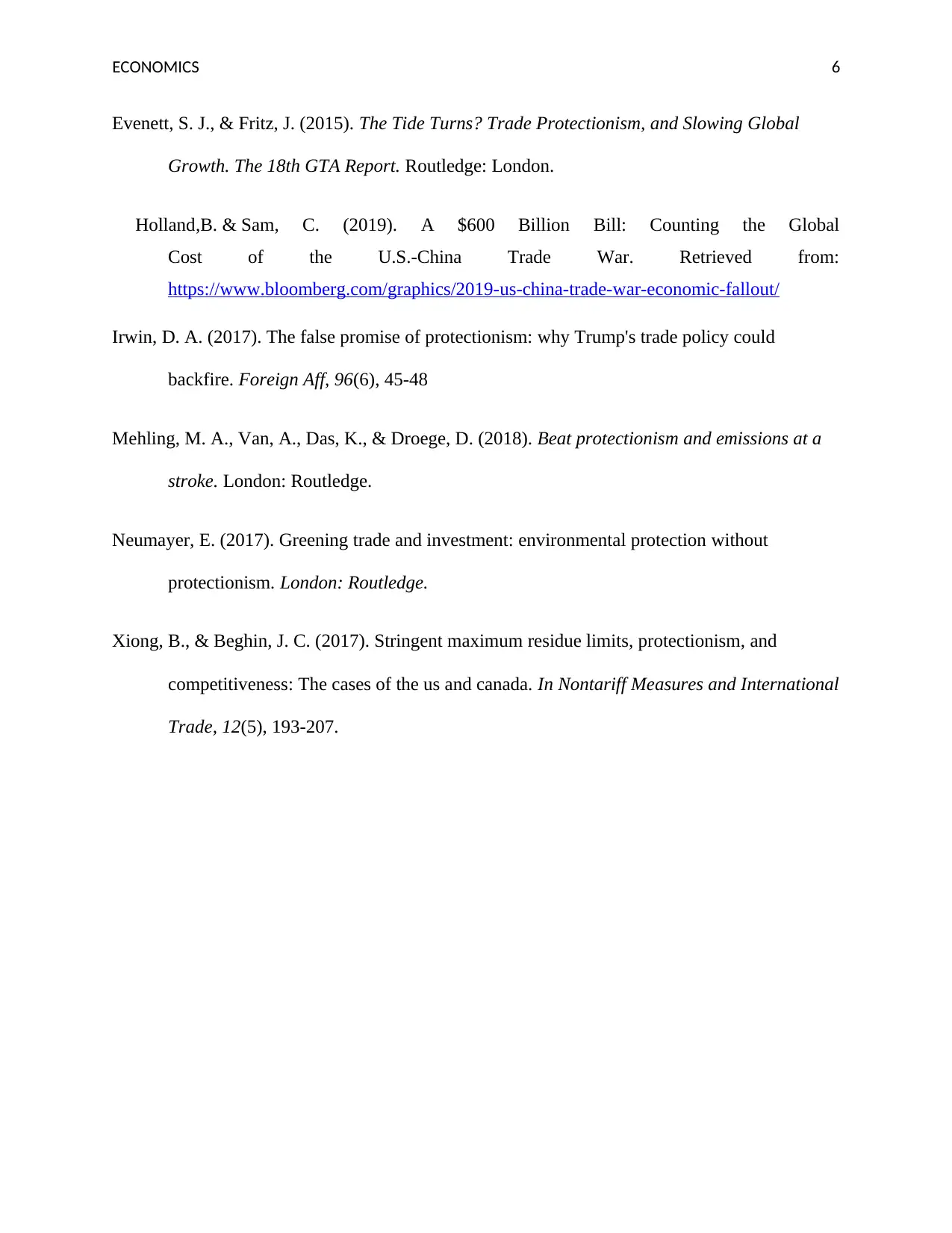
ECONOMICS 6
Evenett, S. J., & Fritz, J. (2015). The Tide Turns? Trade Protectionism, and Slowing Global
Growth. The 18th GTA Report. Routledge: London.
Holland,B. & Sam, C. (2019). A $600 Billion Bill: Counting the Global
Cost of the U.S.-China Trade War. Retrieved from:
https://www.bloomberg.com/graphics/2019-us-china-trade-war-economic-fallout/
Irwin, D. A. (2017). The false promise of protectionism: why Trump's trade policy could
backfire. Foreign Aff, 96(6), 45-48
Mehling, M. A., Van, A., Das, K., & Droege, D. (2018). Beat protectionism and emissions at a
stroke. London: Routledge.
Neumayer, E. (2017). Greening trade and investment: environmental protection without
protectionism. London: Routledge.
Xiong, B., & Beghin, J. C. (2017). Stringent maximum residue limits, protectionism, and
competitiveness: The cases of the us and canada. In Nontariff Measures and International
Trade, 12(5), 193-207.
Evenett, S. J., & Fritz, J. (2015). The Tide Turns? Trade Protectionism, and Slowing Global
Growth. The 18th GTA Report. Routledge: London.
Holland,B. & Sam, C. (2019). A $600 Billion Bill: Counting the Global
Cost of the U.S.-China Trade War. Retrieved from:
https://www.bloomberg.com/graphics/2019-us-china-trade-war-economic-fallout/
Irwin, D. A. (2017). The false promise of protectionism: why Trump's trade policy could
backfire. Foreign Aff, 96(6), 45-48
Mehling, M. A., Van, A., Das, K., & Droege, D. (2018). Beat protectionism and emissions at a
stroke. London: Routledge.
Neumayer, E. (2017). Greening trade and investment: environmental protection without
protectionism. London: Routledge.
Xiong, B., & Beghin, J. C. (2017). Stringent maximum residue limits, protectionism, and
competitiveness: The cases of the us and canada. In Nontariff Measures and International
Trade, 12(5), 193-207.
⊘ This is a preview!⊘
Do you want full access?
Subscribe today to unlock all pages.

Trusted by 1+ million students worldwide
1 out of 6
Related Documents
Your All-in-One AI-Powered Toolkit for Academic Success.
+13062052269
info@desklib.com
Available 24*7 on WhatsApp / Email
![[object Object]](/_next/static/media/star-bottom.7253800d.svg)
Unlock your academic potential
Copyright © 2020–2025 A2Z Services. All Rights Reserved. Developed and managed by ZUCOL.





